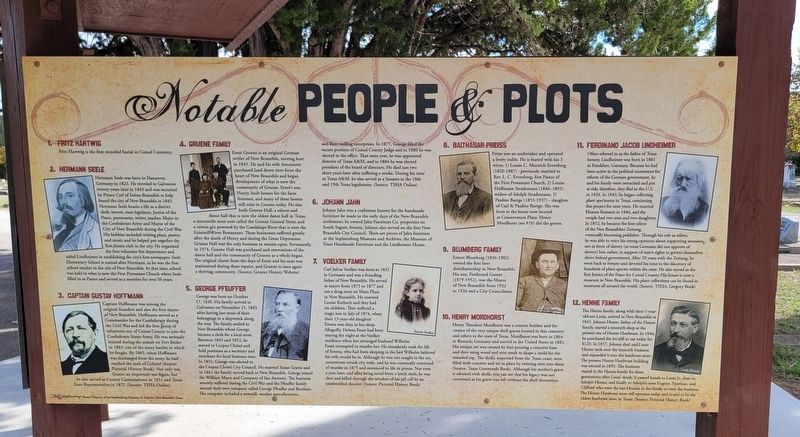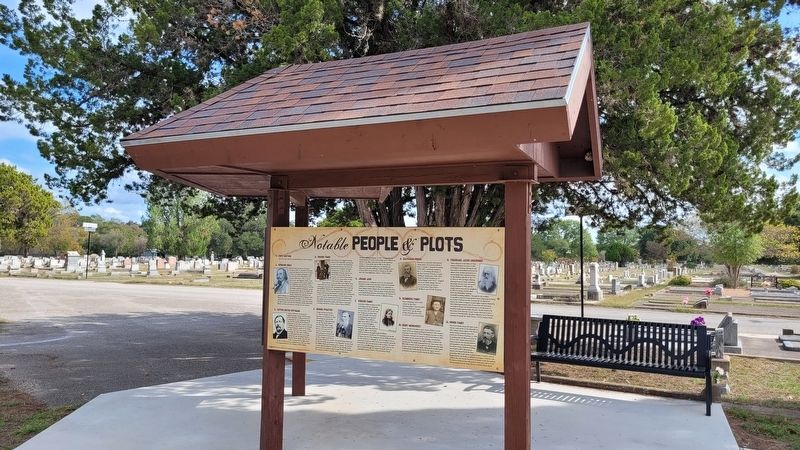New Braunfels in Comal County, Texas — The American South (West South Central)
Notable People & Plots
Comal Cemetery
1. Fritz Hartwig
Fritz Hartwig is the first recorded burial in Comal Cemetery.
2. Hermann Seele
Hermann Seele was born in Hannover, Germany in 1823. He traveled to Galveston twenty years later in 1843 and was recruited by Prince Carl of Solms-Braunfels to help found the city of New Braunfels in 1845. Hermann Seele boasts a life as a district clerk, lawyer, state legislator, Justice of the Peace, postmaster, writer, teacher, Major in the Confederate Army and Mayor of the City of New Braunfels during the Civil War. His hobbies included writing plays, poetry, and music and he helped put together the first drama club in the city. He organized the first volunteer fire department and aided Lindheimer in establishing the city's first newspaper. Seele Elementary School is named after Hermann, as he was the first school teacher in the city of New Braunfels. At that time, school was held in what is now the First Protestant Church where Seele filled in as Pastor and served as a member for over 56 years.
3. Captain Gustav Hoffmann
Captain Hoffmann was among the original founders and also the first mayor of New Braunfels. Hoffmann served as a Commander for the Confederacy during the Civil War and led the first group of volunteers out of Comal County to join the Confederate States Army. He was seriously injured during the assault on Fort Butler in 1863, one of the many battles in which he fought. By 1865, when Hoffmann was discharged from the army, he had reached the rank of Colonel (Source: Pictorial History Book). Not only was Gustav an important war figure, but he also served as County Commissioner in 1851 and Texas State Representative in 1872. (Source: TSHA Online)
4. Gruene Family
Ernst Gruene is an original German settler of New Braunfels, moving here in 1845. He and his wife Antoinette purchased land down river from the heart of New Braunfels and began development of what is now the community of Gruene. Ernst's son, Henry, built homes for the farm foremen, and many of these homes still exist in Gruene today. He also built Gruene Hall, a saloon and dance hall that is now the oldest dance hall in Texas; a mercantile store now called the Gruene General Store; and a cotton gin powered by the Guadalupe River that is now the Gristmill River Restaurant. These businesses suffered greatly after the death of Henry and during the Great Depression. Gruene Hall was the only business to remain open. Fortunately, in 1974, Gruene Hall was purchased and renovations of the dance hall and the community of Gruene as a whole began. The original charm from the days of Ernst and his sons was maintained during these repairs, and Gruene is once again a thriving community.
(Source: Gruene History Website)
5. George Pfeuffer
George was born on October 17, 1830. His family arrived in Galveston on November 25, 1845 after having lost most of their belongings in a shipwreck along the way. The family settled in New Braunfels where George became a clerk for a local store. Between 1845 and 1852, he moved to Corpus Christi and held positions as a secretary and merchant for local business men. In 1852, George was elected to the Corpus Christi City Council. He married Susan Gravis and in 1862 the family moved back to New Braunfels. George joined the William Mann and Company of San Antonio. The business severely suffered during the Civil War and the Pfeuffer family started their own company called George Pfeuffer and Brothers. The company included a sawmill, woolen manufacturers, and flour milling enterprises. In 1877, George filled the vacant position of Comal County Judge and in 1880 he was elected to the office. That same year, he was appointed director of Texas A&M, and in 1884 he was elected president of the board of directors. He died just two short years later after suffering a stroke. During his time at Texas A&M, he also served as a Senator in the 18th and 19th Texas legislatures. (Source: TSHA Online)
6. Johann Jahn
Johann Jahn was a craftsman known for the handmade furniture he made in the early days of the New Braunfels settlement; he owned Jahn Furniture Co. properties on South Seguin Avenue. Johann also served on the first New Braunfels City Council. There are pieces of Jahn furniture at the Sophienburg Museum and Archives, the Museum of Texas Handmade Furniture and the Lindheimer House.
7. Voelker Family
Carl Julius Voelker was born in 1821 in Germany and was a founding father of New Braunfels. He served as mayor from 1875 to 1877 and ran a drug store on Main Plaza in New Braunfels. He married Louise Karbach and they had six children. They suffered at tragic loss in July of 1874, when their 13-year-old daughter Emma was slain in her sleep. Allegedly, Helena Faust had been staying the night at the Voelker residence when her estranged husband Wilhelm Faust attempted to murder her. He mistakenly took the life of Emma, who had been sleeping in the bed Wilhelm believed his wife would be in. Although he was not caught in the act, controversy struck city wide, and he was eventually convicted of murder in 1875 and sentenced to life in prison. Not even a year later, and after being saved from a lynch mob, he was shot and killed through the window of his jail cell by an unidentified shooter. (Source: Pictorial History Book)
8. Balthasar Preiss
Preiss was an undertaker and operated a livery stable. He is buried with his 3 wives: 1) Louise C. Muenich Ervenberg (1820-1887)-previously married to Rev. L.C. Ervenberg, first Pastor of the First Protestant Church, 2) Louise Hoffmann Strademann (1846-1893) widow of Adolph Strademann, 3) Pauline Baetge (1853-1937)-daughter of Carl & Pauline Baetge. She was born in the house now located at Conservation Plaza. Henry Mordhorst (see #10) did the graves.
9. Blumberg Family
Ernest Blumberg (1836-1902) owned the first beer distributorship in New Braunfels. His son, Ferdinand Gustav (1879-1952), was the Mayor of New Braunfels from 1922 to 1926 and a City Councilman.
10. Henry Mordhorst
Henry Theodore Mordhorst was a cement finisher and the creator of the very unique shell graves located in this cemetery and others in the state of Texas. Mordhorst was born in 1864 in Rostock, Germany and moved to the United States in 1882. His unique art was created by first pouring concrete base and then using wood and wire mesh to shape a mold for the rounded top. The shells, imported from the Texas coast, were filled with concrete and set in place by twisting wire into them (Source: Texas Graveyards Book). Although his mother's grave is adorned with shells, you can see that his legacy was not continued as his grave was left without the shell decoration.
11. Ferdinand Jacob Lindheimer
Often referred to as the father of Texas botany, Lindheimer was born in 1801 in Frankfurt, Germany. Because he had been active in the political movement for reform of the German government, he and his family were ostracized and put at risk; therefore, they fled to the US in 1834. In 1843, he began collecting plant specimens in Texas, continuing this project for nine years. He married Eleanor Reinartz in 1846, and the couple had two sons and two daughters. In 1852, he became the first editor of the Neu Braunfelser Zeitung, eventually becoming publisher. Through his role as editor, he was able to voice his strong opinions about supporting secession, not in favor of slavery (as most Germans did not approve of slavery) but, rather, in support of state's rights to govern themselves above federal government. After 20 years with the Zeitung, he went back to botany and devoted his time to the discovery of hundreds of plant species within the state. He also served as the first Justice of the Peace for Comal County. His house is now a museum in New Braunfels. His plant collections can be found in museums all around the world. (Source: TSHA, Gregory Book)
12. Henne Family
The Henne family, along with their 5-year old son Louis, arrived in New Braunfels in 1845. Johann Henne, father of the Henne family, started a tinsmith shop at the present site of Henne Hardware. In 1846, he purchased the lot still in use today for $120. In 1857, Johann died and Louis Henne took over the tinsmith business and expanded it into the handware store. The present Henne Hardware building was erected in 1893. The business stayed in the Henne family for three generations after Louis' death. It passed hands to Louis Jr., then to Adolph Henne, and finally to Adolph's sons Eugene, Norman, and Clifford who were the last Hennes in the family to own the business. The Henne Hardware store still operates today and is said to be the oldest hardware store in Texas. (Source: Pictorial History Book)
Topics. This historical marker is listed in this topic list: Cemeteries & Burial Sites. A significant historical year for this entry is 1823.
Location. 29° 42.797′ N, 98° 6.537′ W. Marker is in New Braunfels, Texas, in Comal County. Marker is at the intersection of Peace Avenue and Dittlinger Street, on the left when traveling south on Peace Avenue. The marker is located in the central section of the Comal Cemetery. Touch for map. Marker is at or near this postal address: 301 Peace Avenue, New Braunfels TX 78130, United States of America. Touch for directions.
Other nearby markers. At least 8 other markers are within walking distance of this marker. Welcome to the Comal Cemetery (here, next to this marker); Heinrich Mordhorst (within shouting distance of this marker); Ferdinand J. Lindheimer (about 300 feet away, measured in a direct line); Ferdinand Jacob Lindheimer (about 300 feet away); Comal County Fair (approx. 0.3 miles away); Church Hill School Building (approx. ¾ mile away); Breustedt House (approx. 0.8 miles away); Site of an Early Mill and Factory (approx. one mile away). Touch for a list and map of all markers in New Braunfels.
Credits. This page was last revised on January 1, 2023. It was originally submitted on December 29, 2022, by James Hulse of Medina, Texas. This page has been viewed 238 times since then and 66 times this year. Photos: 1, 2. submitted on December 29, 2022, by James Hulse of Medina, Texas.

